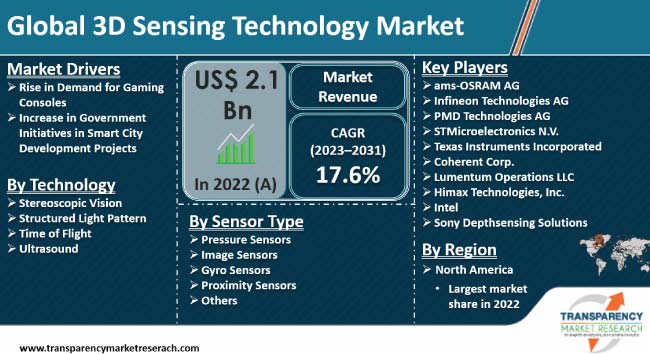
According to a new market report published by Transparency Market Research titled “3D Sensing Technology Market – Global Industry Analysis, Size, Share, Growth, Trends, and Forecast, 2018 – 2026,” the global 3D sensing technology market is expected to reach US$ 4,742.5 Mn by 2026. The market is projected to expand at a CAGR of 19.16% during the forecast period from 2018 to 2026. According to the report, the global 3D sensing technology market will continue to be influenced by a range of factors such as rising demand for 3D sensing technology from many industry verticals including consumer electronics, automotive, and healthcare, and growing popularity of next generation smartphones and gaming devices to enhance the consumer experience with facial recognition, augmented reality, and motion detection among other features. Asia Pacific will continue to be at the forefront of global demand, with the market in the region growing at above 18% through 2026.

Time of flight 3D sensing technology expected to be more lucrative for the market
The global 3D sensing technology market is bifurcated by technology into stereoscopic vision, structured light pattern, time of flight, and ultrasound.Time of flight is projected to grow at a CAGR of more than 20% during the forecast period. In time of flight 3D sensing technology, a flash of light is directly emitted by a projection module, which is then caught by a camera. The time at which light is emitted and goes back to the object is measured. Furthermore, the measured coordinates forms a detailed 3D picture. Due to this type of working mechanism, time of flight technology is heavily used across many industry verticals. It is easy to use and gives very high resolution 3D image. Furthermore, time of flight 3D sensing technology provides correct information about the object, as it nullifies any issue or malfunction in the robotics vision. Moreover, time of flight technology can be easily integrated across a large number of applications from consumer electronics to industrial applications.
Request for a sample:
https://www.transparencymarketresearch.com/sample/sample.php?flag=S&rep_id=39959
Image 3D sensor expected to dominate the 3D sensing technology market
Based on sensor type, the 3D sensing technology market is segmented into pressure sensor, image sensor, gyro sensor, proximity sensors, and others. 3D image sensor is projected to grow at a faster pace, as it is heavily integrated into next generation smartphones around the globe due to its compact size. Furthermore, with the help of a 3D image sensor, any object can be viewed in 3D format and data from the object can be taken for the purpose of analysis. Additionally, this data can be used by other sensors and components to perform the necessary functions.
Consumer electronics end-use industry segment expected to expand at a significant growth rate during the forecast period
Based on end-use industry, the 3D sensing technology market is segmented into consumer electronics, media & entertainment, automotive, security & surveillance, industrial, and others. Consumer electronics segment is projected to expand at a high CAGR during the forecast period. The growth is mainly due to the rising number of next generation smartphones around the globe. Smartphone manufacturers worldwide are adopting 3D sensing technology heavily, as they are introducing highly advanced features such as augmented reality and facial recognition to acquire a large customer base. For instance, in June 2018, Vivo, an Android phone provider showcased 3D sensing solution having sensor points higher than iPhone X’s “Face ID” solution for facial recognition.
Ask for brochure:
https://www.transparencymarketresearch.com/sample/sample.php?flag=B&rep_id=39959
North America to continue to hold significant share in the overall market
In terms of value, North America was the leading contributor to the global 3D sensing technology market in 2017. The contribution is primarily due to the booming 3D sensing technology marketplace along with the presence of well-established players across the region, especially driven by the U.S. and Canada. The U.S. is home to many well-established players from the 3D sensing technology domain including Texas Instruments Incorporated, II-VI Incorporated, Intel Corporation, and Lumentum Holdings Inc.Many players from this region are focusing on expanding production capabilities of 3D sensing technology based solutions. For instance, in July 2018, Finisar Corporation announced the opening of its manufacturing facility in Sherman, Texas. The company plans to use the site to ramp up production capacity of its VCSEL and other 3D sensing related technologies for a wide range of applications.
Infineon Technologies AG, Himax Technologies, Inc., Sony Depthsensing Solutions SA/NV, and AMSAG among others are some of the major players operating in the 3D sensing technology market profiled in this study. Details such as financials, SWOT analysis, business strategies, recent developments, and other such strategic information pertaining to these players have been duly provided as part of company profiling. Many players are providing novel 3D sensing technology to be used across various industry verticals and also establishing partnerships to support the growth of consumer demand.
Read TMR Research Methodology at: https://www.transparencymarketresearch.com/methodology.html
Read Our Latest Press Release:





